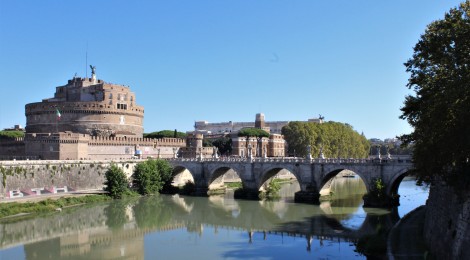
Castel San’t Angelo
Another walking day, this is going to be our mode of transportation until we purchase our transit pass, so wrap up breakfast and off to Hadrian’s mausoleum, or better known as Castel San’t Angelo. Over the years, we’ve read a lot about Hadrian and his accomplishments and he has become a distinguished and venerated individual to us. He served as Emperor of Rome from 117 to 138AD and had quite a few accomplishments, building libraries, forgiving all public debt, unifying the Roman Empire, and our favorite, building a wall across the northern most land of the Empire to keep the barbarians out. This wall can still be seen today going from the North Sea to Irish Sea, 73 miles, dividing England from Scotland. That’s right, Hadrian felt the Scots were barbarians and didn’t want them in his empire!
Hadrian was also one of those leaders that grew up earning his stripes, so to say. He served as a military tribune, a quaestor (low ranking magistrate), a praetor (high ranking judicial officer), governor, archon (chief magistrate), and so on until one day – boom shakalaka- Emperor!
Must be one of those things you feel coming on, death, end of the rat-race, cooling the heels, seeing who was right in that argument about whether heaven exists or not, Hadrian was in the zone. Feeling like things were closing in, he commissioned the building of his mausoleum in 134AD.
The design was simple, a cylindrical tower with a garden and a golden statue of a quadriga (chariot pulled by 4 horses) at the top. Unfortunately for Hadrian, he died a year before it was completed, 138AD.
Today, it’s much more than the initial design. Over the course of these 1900 years or so, there have been numerous changes to the tomb. First, it was converted into a military fortress complete with moats, ramparts, the works. Then the Pope, Nicholas III, converted it to his “castle” in the 14th century. Good thing because Pope Clement VII found refuge here during the sacking of Rome in 1527. Later, Pope Paul III built an apartment here, just because. And being such a nice fortification, why not use it as a prison, so that happened around the 1700’s complete with executions and the like.

 Finally, decommissioned in 1901, the castle became what it is today, a museum. Hadrian’s ashes have long been scattered and the only remaining evidence he was here is an empty sarcophagus that bears his inscription. I wonder what he would think of the place now? One other thing about Hadrian, just before his death he selected an heir to the throne by adopting a young boy, age 18. The boy did become emperor after Hadrian’s death, his name Marcus Aurelius, straight from Gladiator and Russel Crowe!
Finally, decommissioned in 1901, the castle became what it is today, a museum. Hadrian’s ashes have long been scattered and the only remaining evidence he was here is an empty sarcophagus that bears his inscription. I wonder what he would think of the place now? One other thing about Hadrian, just before his death he selected an heir to the throne by adopting a young boy, age 18. The boy did become emperor after Hadrian’s death, his name Marcus Aurelius, straight from Gladiator and Russel Crowe!


 That was our adventure for the day. Nice to have time to slow-roll fighting the crowds to see these sites. Tomorrow were thinking of doing the hop-on / hop-off bus just to cruise the city. Weather should be good, mid 70’s and no rain.
That was our adventure for the day. Nice to have time to slow-roll fighting the crowds to see these sites. Tomorrow were thinking of doing the hop-on / hop-off bus just to cruise the city. Weather should be good, mid 70’s and no rain.
Til then….happy trails













